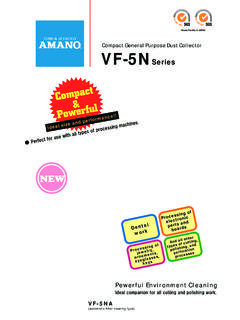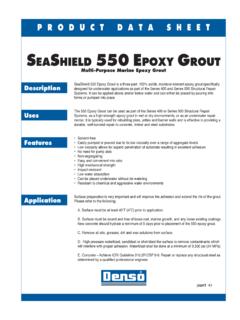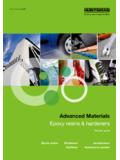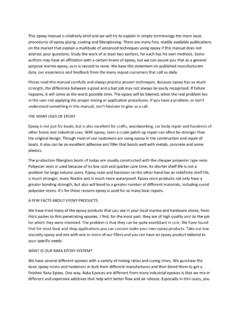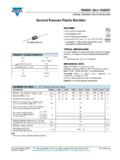Transcription of Heavy Duty Epoxy Coating - industryiron.com
1 DEVRAN 220 Heavy duty Epoxy Coating Cat. # 220 BXXXX / 220C0903 Generic:Catalyzed Polyamide EpoxyGeneral Description:A high performance, multi- purpose , two-component chemically-cured Epoxy semi-gloss Coating for industrial or high performance architectural Coating (HIPAC) applications. For use on properly prepared steel or masonry surfaces: Also used on concrete floors and interior primed drywall, and plaster surfaces. Use as a filler for open textured concrete Uses:Ideal for structural steel, piping, tanks, and equipment in chemical, fertilizer, power plants, petroleum refineries, pulp and paper mills, water and sewage treatment plants and mining operations. Can also be used in the hard service areas of correctional facilities, schools, commercial and restaurant kitchens were a high performance architectural Coating (HIPAC) is :off-white (tintable), ready-mixed, & custom colorsFinish:Semi-Gloss Reduction Solvent:T-10 Thinner.
2 Clean-up Solvent:T-10 Thinner Weight/ ( kg/L) VOC(EPA 24): (284 g/L) Thinned 10% with T-10 thinner <340 g/L ( ) Solids By Volume (ASTM D 2697-7 days):67% + 2% Theoretical Coverage at Mil (25 microns) Dry:1075 sq. ft. ( m2/L)Recommended Film Thickness:5-7 mils (125-175 microns) dry mils (188-263 microns) wet. (Make allowances for loss due to overspray & irregular surfaces.) Systems:Please consult the appropriate system guide, the particular job specification or your ICI Paints Representative for proper systems using this product. Systems must be selected considering the particular environment involved. Minimum Dry Time (ASTM D 1640):At 6 mils (150 microns) DFT (Use of cold weather additive will decrease times noted.)
3 See cold weather applications on back page.)Substrate Temperature 50 F (10 C) 60 F (16 C) 70 F (21 C) 80 F (27 C)Minimum Recoat 20 Hours 8 Hours 6 Hours 4 Hours Dry Hard 35 Hours 22 Hours 16 Hours 10 Hours Maximum Recoat_____Self 90 Days 90 Days 90 Days 90 Days 359, 389 14 Days 14 Days 14 Days 14 Days 378, 379 7 Days 7 Days 7 DaysVentilation, film thickness, humidity, thinning, and other factors can influence the rate of :The above table provides general guidelines only. Always consult your ICI Paints Representative for appropriate recoat windows since the maximum aged recoat time of this product may be significantly shortened or lengthened by a variety of conditions, including, but not limited to humidity, surface temperature, and the use of additives or thinners.
4 The use of accelerators or force curing may shorten the aged recoat of individual coatings. The above recoat windows may not apply if recoating with a product other than those listed above. If the maximum aged recoat window is exceeded, please consult your ICI Paints Representative for appropriate recommendations to enhance adhesion. Failure to observe these precautions may result in intercoat Life:Over 24 months at 77 F (25 C) unopened Mix Ratio By Volume:1 (base): 1 (converter) see mixing instructions. Induction:15 minutes at 60-80 F (16-27 C) after mixing see mixing instructions. Pot Life:8 hours @ 77 F (25 C) & 50% Advantages: Excellent corrosion protection Excellent solvent and chemical resistance resists splash and spillage of solvents, alkalis, salts, moisture, oils, greases, foodstuffs and detergents Low VOC Self-priming on steel or masonry Abrasion resistant High build/high solids Coating Limitations of Use:Exterior exposure will cause a color change, early dulling, and loss of gloss, but this does not affect protective properties.
5 Epoxy coatings may yellow during application and cure if exposed to the combustion by-products of improperly vented fossil fuel burning heaters. Commonly finished with DEVTHANE Urethane Enamel for maximum exterior color & gloss :(ASTM D 4541) ExcellentSalt Spray Resistance:(ASTM B 117) ExcellentDirect Impact Resistance:(ASTM D 2794) Very GoodAbrasion Resistance:(ASTM D 4060) ExcellentHumidity Resistance:(ASTM D 4585) ExcellentExterior Exposure:(45 South Lt. Industrial) Very Good (Normal, expected loss of gloss for Epoxy coatings)Service Temperature Limits:250 F (121 C) dry Hardness: (ASTM D 3363), 7 day cure @ 77 F (25 C) - 5 BChemical Resistance:(ASTM D 1308 24 hr. contact) Excellent. Resists splash and spillage of alkalis, salts, moisture, oils, greases, food stuffs, and detergents, 50% sodium hydroxide, 28% ammonia, 5% trisodium phosphate, 25% citric acid, 25% lactic acid, 10% sulfuric acid, crude oil, 10% hydrochloric acid, 20% tannic acid, 5% sodium chloride, 10% ammonium hydroxide, sewage, 50% ethanol, gasoline, methanol, kerosene, naphtha, xylol.
6 All results based on testing of system comprised of two coats of DEVRAN 220 at 6 mils (150microns) DFT per coat. DANGER! FLAMMABLE. HARMFUL OR FATAL IF label and Material Safety Data Sheet Prior to Use. See other cautions on last page. DSF3-0696 PRECAUTIONS DIRECTIONS FOR USE Back Page: 220 BXXXX / 220C0903 Surfaces must be dry, clean, free of oil, grease, form release agents, curing compounds, laitance, other foreign matter and be structurally sound. Remove all loose paint, mortar spatter, mill scale, and rust. All direct to metal coatings provide maximum performance over blasted surfaces. There are situations and cost limitations which preclude blasting. DEVRAN 220 Epoxy was designed to provide excellent protection over less than ideal surface preparation.
7 The minimum standard for non-immersion service is SSPC-SP2 (ISO-St2). This minimum surface preparation standard applies to steel that has been previously abrasive blasted, coated and deteriorated. Where very rusty surfaces still remain after cleaning use PRE-PRIME 167 sealer before application of DEVRAN 220 Surfaces: Steel New steel surfaces should be initially blasted to a minimum commercial blast cleanliness in accordance with SSPC-SP6 or ISO-Sa2 for non-immersion service. Blast profile on steel should be to mils (38-63 microns) in depth and be of a sharp, jagged nature as opposed to a peen pattern (from shot blasting). Surfaces must be free of grit dust. Concrete Block Remove loose aggregate and repair voids. Fill with this product, BLOXFIL 4000, TRU-GLAZE-WB 4015 or DEVFIL 145 fillers.
8 Concrete Floors, Poured Concrete Cure at least 30 days. Acid etch or abrasive blast slick, glazed concrete or concrete with laitance. Prime with PRE-PRIME 167 sealer or this Prime with a premium acryliclatex vapor barrier primer sealer. Galvanized Steel Remove dirt and oils by solvent cleaning or with DEVPREP 88 cleaner followed by a thorough water rinsing. Prime with DEVRAN 205 or DEVRAN 203 Epoxy primer for non-immersion. For severe moisture condition, abrasive blasting is recommended before priming with DEVRAN 201 Epoxy primer. Choice of primer dependant on local VOC regulations. Previously Painted Surfaces:Old coatings should be tested for lifting. If lifting occurs, remove the lifted Coating . Otherwise scuff sand glossy areas and aged Epoxy coatings.
9 Clean aged Epoxy or urethane coatings with DEVPREP 88 cleaner or other suitable cleaner. Remove cracked and peeling paint. Prime bare areas with primer specified under New ! If you scrape, sand, or remove old paint, you may release lead dust. LEAD IS TOXIC. EXPOSURE TO LEAD DUST CAN CAUSE SERIOUS ILLNESS, SUCH AS BRAIN DAMAGE, ESPECIALLY IN CHILDREN. PREGNANT WOMEN SHOULD ALSO AVOID EXPOSURE. Wear a NIOSH-approved respirator to control lead exposure. Clean up carefully with a HEPA vacuum and a wet mop. Before you start, find out how to protect yourself and your family by contacting the National Lead Information Hotline at 1-800-424-LEAD or log on to Coating may also be applied by brush or roller. Care should be taken that proper anduniform thicknesses are obtained.
10 For roller work use a clean synthetic roller with 1/4''-1/2'' nap. New rollers should be thoroughly wet with the specified thinner and spun vigorously to remove loose fibers. Brushing and rolling may require multiple coats to achieve correct film thickness and/or hiding. Cold Weather Applications:For substrate temperatures between 25 F (-4 C) and 40 F 5 C), cold weather additive 060A0000 may be added. Two pint containers of 060A0000 may be added to the converter portion of a 10 gallon kit of DEVRAN 220. Thoroughly mix the 060A0000 additive in the converter with a power mixer prior to adding the converter to the base portion. Caution: Use of the cold weather additive will shorten the pot life. Dry Time:(ASTM D 1640): At 6 mils (150 microns) DFT with Cold Weather Additive (060A0000) 25 F (-4 C) 30 F (-1 C) 40 F (4 C) To Recoat 20 Hours 14 Hours 6 Hours Dry Hard >30 Hours 26 Hours 20 Hours Spreading Rate:Apply at 150-215 sq.

